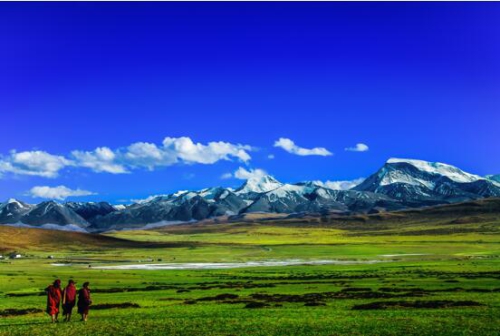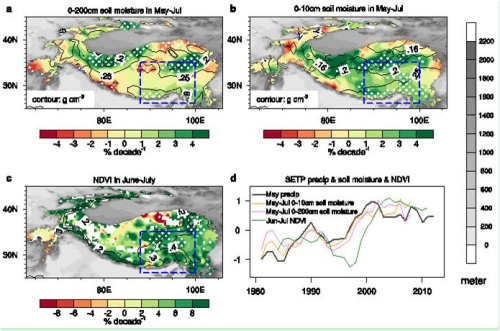Tibetan Plateau Gets Wetter and Greener in Early Summer in Recent Decades
Date:2017-08-11
Known as the “water tower of Asia”, the Tibetan Plateau (TP) is the source of the ten largest rivers in Asia, supporting more than 1.4 billion people and exerting a substantial influence on the water resources, agriculture, and ecosystems of the downstream countries. The change of water supplies over the TP has long been a “hotspot” of climate change research. Recently, a new study conducted by Dr. ZHANG Wenxia, Prof. ZHOU Tianjun and Dr. ZHANG Lixia from Institute of Atmospheric Physics, Chinese Academy of Sciences shows that the TP has been getting significantly wetter in May since 1979.

Tibetan Plateau is getting wetter and greener (Image by Pixabay)
According to their study, both increased precipitation frequency and intensity have contributions to a wetter climate over TP. “Our further analyses show that the phase transition of Interdecadal Pacific Oscillation around the late 1990s has promoted an earlier onset of the South Asian summer monsoon since 1979. ” says the first author Dr. ZHANG, “ It happens via increasing meridional thermal contrast between the Indian Ocean and the Asian landmass in the pre-monsoon season.” The earlier onset of the South Asian summer monsoon is then favorable for increased southwesterly water vapor transport and hence a wetting TP in May.

Climatology (contours: g cm-3) and trends (shadings: % decade-1 of the climatology) of (a) 0–200 cm and (b) 0–10 cm soil moisture content in May–July during 1979–2010. (c) Same as (a) but for the NDVI in June–July during 1982–2013 (contours: 1; shadings: % decade-1). Stippling indicates significance at the 5% level. Grey shadings denote elevation of the topography (m). (d) Normalized time series of the amount of precipitation in May, soil moisture content in May–July, and NDVI in June–July averaged over the southeastern TP (blue boxes in a–c; 26° –35° N, 88° –100° E), with a five-year running smooth.
“The wetting TP has significant consequences in that it has influenced the regional hydrological cycle and ecosystem,” says Prof. ZHOU Tianjun. The coherent increases in the soil moisture content and vegetation activities confirm the precipitation trend, indicating a wetting and greening TP in the early summer in recent decades. “This is especially beneficial for agriculture during the vegetation growing season. The increased rainfall also indicates richer water release from the TP to downstream areas, suggesting enhanced water availability in Asia.”
This work is recently published in J. Geophys. Res. Atmos. and highlighted by AGUniverse https://www.magnetmail.net/actions/email_web_version.cfm?recipient_id=1035245179&message_id=14356100&user_id=AGU_&group_id=1048659&jobid=37668060
Citation:
Zhang, W., T. Zhou, and L. Zhang (2017), Wetting and greening Tibetan Plateau in early summer in recent decades, J. Geophys. Res. Atmos., 122, doi:10.1002/2017JD026468.
http://onlinelibrary.wiley.com/doi/10.1002/2017JD026468/full
Contact: ZHANG Wenxia, zhangwx@lasg.iap.ac.cn
